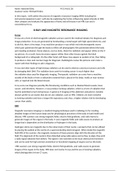Name: Adewale Eletu P5 & M3 & D3
Assessor name: Michael Hickey
In this report, I will outline the process of magnetc resonance imaging (MRI) including the
instrument/equipment used. I will also be explaining the factors infuencing signal intensity in MRI,
then compare and evaluate the appearance of bone and sof tssue in an MRI scan and a
conventonal X-ray.
X-RAY AND MAGNETIC RESONANCE IMAGING
X-rays
X-rays are a form of electromagnetc radiaton and are used in the medical industry for diagnosis and
image producton. X-ray are generated by bombarding a metal target with high speed electrons, and
to do this, there a few steps. X-ray machines produce x-rays which emit electromagnetc waves
which pass painlessly through the body to refect oo photographic flm positoned behind the body
part needing evaluated. Dense objects, such as bone, block the radiaton and appear white on the X-
ray picture. As a result, bony structures appear whiter than other tssues against the black
background of a radiograph. On the other hand, sof tssue may appear as pockets of air, thus failing
to produce a clear and concise image for diagnosis. Radiologists review the pictures and create a
report with their fndings to aid in diagnosis.
X-rays and other types of high-energy radiaton can be used to destroy cancerous tumours and cells
by damaging their DNA. The radiaton dose used for treatng cancer is much higher than
the radiaton dose used for diagnostc imaging. Therapeutc radiaton can come from a machine
outside of the body or from a radioactve material that is placed in the body, inside or near tumour
cells, or injected into the blood stream.
X-ray scans can diagnose possibly life-threatening conditons such as blocked blood vessels, bone
cancer, and infectons. However, x-rays produce ionising radiaton, which is a form of radiaton that
has the potental to harm living tssue. In general, if imaging of the abdomen and pelvis is needed,
doctors prefer to use exams that do not use radiaton, such as MRI. Children are more sensitve
to ionising radiaton and have a longer life expectancy and, thus, a higher relatve risk for developing
cancer than adults.
MRI
Magnetc resonance imaging is a medical imaging technique used in radiology to for creatng
detailed images of the human body and for physiological processes of the body in both health and
disease. MRI scanners use strong magnetc felds, electric feld gradients, and radio waves to
generate images of the organs in the body. It uses magnetc felds and radio waves to produce an
image that is dependent on the distributon of hydrogen in the body.
Hydrogen atoms are magnetc due to the natural spin of their nuclei, a property that can be utlised
by placing the patent at the centre of a superconductng electromagnet. When inside the magnetc
feld (B0) of the scanner, the magnetc moments of these protons align with the directon of the
feld. The alignment of the nuclei is then disturbed using radio pulses and as they re-align, they emit
a radio signal obtained from before. The signal is very sensitve to the local chemical environment
and can be used for high contrast anatomical or functonal mapping of organs such as the brain.
MRI scanners use strong magnetc felds, electric feld gradients, and radio waves to generate
images of the organs in the body. MRI does not involve X-rays and the use of ionizing radiaton,
which distnguishes it from CT scans.




